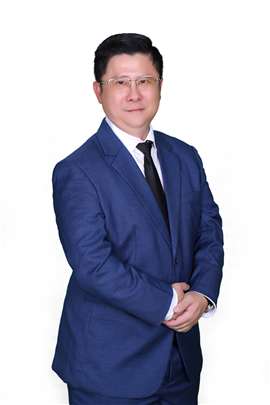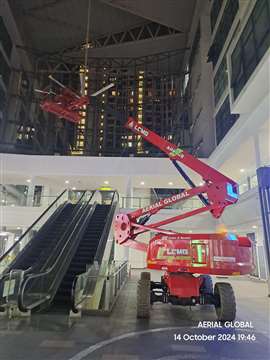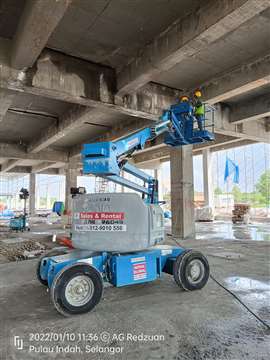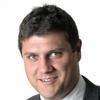Is Malaysia the rental gateway to Southeast Asia?
05 November 2024
The Malaysian access market is in a transitional stage that will set the tone for much of the rest of Southeast Asia, according to Alex Tan, business development manager at distributor and training company Aerial Global.
As a member of IPAF’s new Asia Council and chair of its working group, Tan is well versed in the latest trends in the sector, which includes an influx of China-based rental companies and producers into the country that is set to change the course of the MEWP industry across the region.
 Alex Tan, business development manager at Aerial Global.
Alex Tan, business development manager at Aerial Global.
The arrival of new competitors is combined with a halt on major projects in Malaysia, which is putting pressure on domestic companies and rental rates, says Tan.
“There has been a downturn this year for the sector due to there being some big gaps in projects.
A lot of them stopped last year or by the end of the first quarter this year. Unfortunately, phase two of these projects has been delayed, in many cases for more than six months.”
These include a range of manufacturing plants and warehouses, along with new-build data centers and electronics plants by Korean and Chinese investors.
“It creates a longer gap for us as the earthmoving equipment will be brought in first, then we have to wait another four or five months for the initial structure to be done, then the MEWPs will go in.
“That creates a big gap from January this year to September, particularly in the central regions of the country.”
As Tan says, it is the central region of the country which includes Kuala Lumpur, that is seeing the most significant slowdown, with northern and southern areas faring better.
As Tan describes there is an abundance of land in the southern region, combined with the fact that the country’s current king, His Majesty Sultan Ibrahim King of Malaysia, is based there in the most southerly state of Johor, which boarders with Singapore.
The king was elected on 26 October 2023 and under the Malaysian constitution has a five-year rule. “Therefore we expect there will be more projects kick started in Johor,” explains Tan.
|
About Alex Tan & Aerial Global Alex Tan is a longstanding member of the aerial platform industry and apart from being business development manager at Aerial Global, Tan is a member of the IPAF Asia Council, formed last year, and is chairman of the council’s Working Group. Tan says, “IPAF has done a very good job, helping our authorities to recognize IPAF and their efforts and are expanding their activities with local authorities and other organizations.” As a distributor Aerial Global represents boom lift and scissor manufacturers Hered and Rees and spider specialist Teupen. |
“If you talk about data centers Johor Bahru will be one of the key areas for those projects, followed by central areas like Kuala Lumpur. But it’s still in the early stages in the central region.” Microsoft and Amazon are just two of the tech giants that are looking to Malaysia as a hub for their data requirements.
The Northern region and particularly the most northerly state of Penang, is known for semiconductor production and its skilled labour force. “It is famous as a tech park and a lot of chip manufacturers are building up there and other high-end industries. Most of investors in those business areas are up there.”
Multiple factors
While economic cycles are part and parcel of any business environment, for Malaysian rental companies it is not just a case of sitting out the tough times ahead of the inevitable uptick. There is a new challenge that will affect their prospects long term.
That is the new and increasing interest from Chinese rental and manufacturing companies in the country. “We see there is an opportunity in the new tech projects, but we have also seen a great challenge arise. We have seen overseas rental companies setting up in Malaysia, along with trading companies and a couple of manufacturers setting up facilities here.”
According to Tan, Horizon Construction Development, China’s largest rental company is one of those to have set up there, along with manufacturers Noble Lift and Hered, which all now have facilities in the country, while there are also imports from other major access OEMs based in China. “It affects us a lot,” says Tan, “Manufacturers are establishing their sales outlets and warehouses in Malaysia and some are also approaching the end user directly.”
This has in turn affected rental rates, which Tan says have seen a 40%-50% drop in as little as six months.
“This is purely from new rental companies and manufacturers coming into the country. The fleet they are bringing in is huge compared to the buying power in the country.”
Imports on the rise
 JLG boom carry out maitenance work. (Photo: Aerial Global).
JLG boom carry out maitenance work. (Photo: Aerial Global).
Malaysia has an annual intake of around 1,200 – 1,600 MEWPs each year. On top of that, “The new rental companies coming into Malaysia have brought in 1,000 units in the past 12 months to set up rental fleets in the country.”
“This really is a sudden surge of units coming to the country,” says Tan.
Many of the MEWPs coming into the country are used units from rental fleets in China, says Tan “which will increase the challenge for local players too.
“At the same time, with there not being many projects running in the center regions. There are there those projects in the south, but compared to the last two years, even those have been reducing.”
In total, Tan believes there are between 10,000 – 12,000 MEWPs operating in Malaysia
Tan adds, “Due to the market the buying power has dropped a great deal and the number of new machines imported has dropping off.”
However, the number of new machines entering the market has not dropped off entirely. This, says Tan, is due to new local rental companies have bought brand new machines from Chinese OEMs – a trend that has been increasing over the last two years. In addition, a new regulation was introduced on 1 June this year, which encourages the industry to import new MEWPs into the country, rather than used.
The Occupational Safety and Health (Plant Requiring Certificate of Fitness) Regulation 2024 gives advantages to those who import new MEWPs by simplifying the process through more straightforward design approvals and certifications. The act only covers machines that are US-based ANSI or European EN certified. Other global certifications like the JIS, Korean KS or Chinese GB standards are not recognized and come under the same category as used equipment.
 LGMG boom used for mall maintenance. (Photo: Aerial Global).
LGMG boom used for mall maintenance. (Photo: Aerial Global).
While the act doesn’t stop being used and non-ANSI and -EN machines entering the market entirely it makes the process more onerous. “You can still bring it,” explains Tan, “But the criteria and documentation that you need to submit will be more complicated.”
Looking at the advantages of the act, Tan adds, “By doing this it means we will have one of the most advanced rental fleets in the world.”
Today, around 60% of the MEWP population is Malaysia is acquired as used. Breaking that down into equipment type, the percentage of new scissor lifts entering the country is much higher than for boom lifts, a majority of which enter Malaysia as used equipment.
Then there is the country of origin. “If we are talking about purchases from Europe or the US then rental companies are facing higher costs and longer lead times for new products. Nowadays China manufacturers are offering very interesting sales packages, especially in terms of pricing and payment terms.”
“We have a real concern about ROI as we can see the rental rates are dropping so we have no choice but to look at Chinese companies.
“It’s a difficult situation and with the low rental rates combined with the fact that we are encouraged by the government to buy new equipment.”
Unique market
This unique set of dynamics in the market may mask that fact that Malaysia has been one of the region’s fastest growing access markets alongside Thailand Vietnam and the Philippines.
“In last five years there have been more and more rental companies with less than 20 units that have started up.” Which has led to there being more than 100 rental companies in the country.
Another facet to the country’s new dynamic is that the largest rental company is now country is Horizon Construction Development, which holds an estimated 1,500 – 1,800 MEWPs in its fleet, according to Tan.
Just a year ago the largest renter in the country was domestic company TH Tong Heng Machinery which currently has 1,200 units in its fleet, followed by Schmetterling as the second biggest player, which expanded its coverage to Singapore recently.
 Genie in construction work in Malaysia. (Photo: Aerial Global).
Genie in construction work in Malaysia. (Photo: Aerial Global).
As Tan explains Malaysia is an attractive market for Chinese companies. “Before the pandemic there were a lot of Chinese tourists in Malaysia.
“Malaysians speak multiple languages, therefore Chinese people coming into Malaysia have no language and communication issues, and we have multiple races and food here. The culture is suitable to them too.”
Secondly, the cost of setting up a business in Malaysia is much lower than it is in the mature access market of Singapore. “To set up a base and a warehouse in Singapore is very costly.”
The area of choice for these new bases tends to be in the central regions of Shah Alam and Rawang and notably the capital Kuala Lumpur. “They will also of course set up branches in areas of development like Penang and Johor.”
“And these will include service centers and after sales engineers based in Malaysia for fast delivery to the rest of Southeast Asia.”
Another development in Malaysia is the rise of the generalist rental company, as the rental market becomes more mature. “As I mentioned, nowadays the rental rate for MEWPs is dropping, and it is therefore time for the rental companies to diversify their ranges, and we have already seen this starting over the last two years.
“They are looking at skid loaders, forklifts, gensets, lighting towers, compressors and mobile cranes.”
Tan adds, “I would say over the next five years, things will change. Operations and sales is no longer just about the MEWP – there will be a new strategy mostly towards diversification and more towards digitalization and sales technologies.”
“It’s a new era for Southeast Asia.”
|
Truck mounts in Malaysia Malaysia’s access equipment market was once dominated by truck mounts, with self propelled equipment being the less prominent product type in the country. Anomalies like this are not uncommon in young access and rental markets. In Malaysia the custom is for construction projects to start with the core building work, with infrastructure like roadways, power and street lighting to follow much later on. This means truck mounts are brought in for their rough terrain capabilities. “There is still work that requires truck mounts, where we have muddy off road conditions on construction sites. It means truck mounts with outriggers are still the most suitable machines in the early stage of construction work. Tan adds, “Also, you don’t have the transportation charges with truck mounts. An end user may prefer a truck mount, especially projects that require short term rental, of a few days or up to two weeks - do not have pay for the delivery charges as they are self-drive. With scissors you have the equipment rental rates and the delivery charge.” As the country has become more educated to the benefits of MEWPs, their numbers have risen, bringing the proportion of the truck mounts in the market down. Nevertheless, there are still 4000-5000 truck mounts operating in the market. Tan concludes, “I think over the next five years that number will reduce further, because we can see from the last few years more and more truck mount owners are moving towards scissors and booms, as the fact that you don’t require drivers and operators to handle the machines is becoming a beneficial.” |



